by Malcolm Woods
Solidworks is one of the most widely used software for 3D modeling, and it's used especially by engineers. This application offers both 2D CAD and 3D CAD features. You'll be able to create 3D blueprints for your engineering projects and ascertain whether they will work or not.
Needless to say, Solidworks is an extremely beefy application. It requires a considerable amount of power to work properly. Although you might be able to fire it up using lighter computers, the workflow won't be as efficient.
Only the best graphics card for Solidworks is capable of providing a smooth user experience. Today, we'll take a look at the top graphics cards that the market is offering.
Contents
Just Follow This Table For Take A Quick Decision
| Product Image | Name | Editor's Rating | Price |
 | Asus GeForce GT 710 | 4.5 / 5.0 | Price Check |
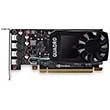 | PNY NVIDIA P1000 | 4.8 / 5.0 | Price Check |
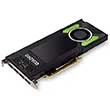 | PNY Quadro P4000 | 4.5 / 5.0 | Price Check |
 | NVIDIA Quadro 600 | 4.7 / 5.0 | Price Check |
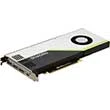 | PNY Quadro 4000 | 4.7 / 5.0 | Price Check |
There are multiple ways in which a graphics card can enhance your Solidworks experience. Let's take a look at a handful of benefits.
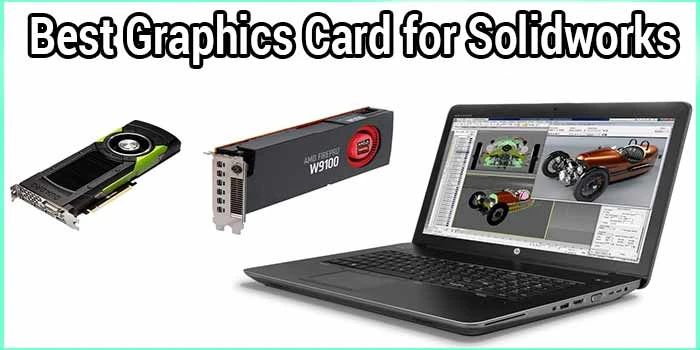
A capable graphics card will allow you to see what you're doing in real-time, thus offering higher efficiency. If you aren't capable of seeing the changes in real-time, you'll only end up being drawn back.
With the real-time rendering feature, you'll be capable of finishing your tasks soon.
You need to export a project in either picture or video format so that it's easier for you to present. With the help of a quality graphics card, the time required for exporting your projects will reduce dramatically. This will allow you to make your pipeline more efficient.
If you're a person who works on multiple projects simultaneously, then getting one of the best graphics cards will help you work on more projects in less time.
An older graphics card won't be able to cope up with modern Solidworks versions, as they stop being compatible after a certain point. This is why we highly recommend switching to a newer graphics card. Doing so will help you enjoy the latest features and updates seamlessly.
In this section, we'll explore the top five picks for the top GPU for Solidworks. Here you'll find products that were chosen after thorough market research, and you'll find a product for yourself irrespective of what your budget may be.
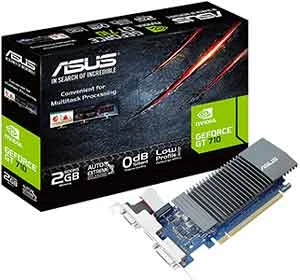
A lot of you might be wondering why are we reviewing the ASUS GeForce GT710 as our first pick for the best graphics card for Solidworks. Well, you do have a point. This is a comparatively older GPU. It doesn't provide best-in-class performance, and it certainly doesn't provide any special features.
We're completely aware of that. Still, we must emphasize that most people looking for a GPU aren't professionals, and many are on a budget.
If you're a person who's on a budget and is looking for a decent upgrade over integrated Intel graphics, then the GT 710 is the perfect choice for you. This is cheap and capable of driving Solidworks.
While it lacks compatibility for the new and special features, it's quite capable of handling the regular workload well. This GPU supports up to three displays, allowing the simultaneous usage of three monitors.
It also comes with a beefy heatsink that provides passive cooling, best for those who're looking forward to building a silent rig. Another amazing thing about this GPU is the power consumption. With the 19-watt TDP, you can practically run this GPU on any rig with a power supply rating of over 300 watts.
You'll also get the proprietary ASUS GPU Tweak II software for controlling this GPU, and it'll allow easy maintenance.
Highlighted Features

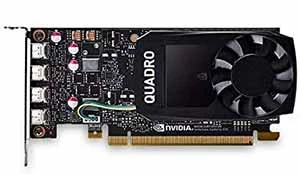
The Quadro P1000 is an NVIDIA card. It's produced by the AIB PNY. This card comes from one of the earlier generations of Quadro series graphics cards, and it's quite capable of handling light to moderate workload even today. At least, it'll perform far better than the GT710.
Coming with 640 CUDA cores, this card allows CUDA acceleration, which is a nice touch. The single-precision FP32 performance peaks at a staggering 1.894TFLOPS, which is surprising from a card so old.
It also provides a GPU memory of GDDR5 4GB, coupled with a memory bandwidth of 80GB/s and a 128-bit interface.
With a moderate level of memory, designers and developers will be capable of working on multiple complex elements at once. If you're creating a single complex element, the performance will be buttery smooth. The performance won't stutter until you reach a great number of elements.
While you won't get the fastest renders from this, the render times will be pretty fast. However, you might not be able to see the changes in real-time. If that is what you're looking for, then you better go for a superior GPU.
Other than that one factor, this one's a phenomenal Solidworks video card that can be purchased at a reasonable price.
Highlighted Features


This one's definitely for those who are looking for a beefy graphics card, but not willing to push their pockets as far as to get the latest model. If that sounds like you, then you better check this one out.
The PNY Quadro P4000 is a graphics card from NVIDIA. It provides an astounding number of CUDA cores. You'll get around 1792 CUDA cores from this product. The single-precision FP32 performance peaks at 5.2 TFLOPS.
You'll also be getting a GPU memory of GDDR5 8GB, which is twice as much as what the PNY Quadro P4000 is offering. Then again, that huge amount of memory comes coupled with a memory interface of 256-bit and a bandwidth of 243GB/s.
Overall, this is capable of pushing Solidworks to unleash its full potential.
It's true that such a powerful card can't be cooled passively. With that in mind, the developers offer a full covering heatsink on this card with a blower fan. The cooling system is more than capable of keeping the core well under the maximum temperature, and that too without producing much fan noise.
This card comes with four display ports, meaning that you'll be able to control up to four monitors simultaneously. It's VR ready too, so you'll be able to create VR experiences through modeling.
Highlighted Features

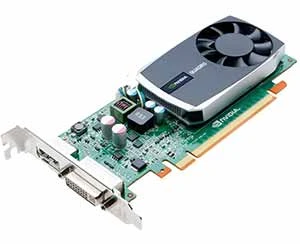
Next up, we have the NVIDIA Quadro 600, and this one too is from the AIB PNY. This is one of the oldest models of the Quadro series. We recommend this GPU only to those who have extreme budget constrictions.
This GPU offers a relatively poor performance than the other GPUs on this list and the market. Still, we believe that there are some who may yet make something out of it, especially considering that it costs extremely low.
It offers a GPU memory of 1GB DDR3. While this isn't much, it will provide better performance than any integrated graphics out there. There are 96 CUDA cores built into this GPU, so you'll be getting a solid performance due to the CUDA acceleration.
The memory bandwidth of this GPU is 25.6GB/s. This is good enough for driving the basic Solidworks workflow. You'll be able to create a single complex element at a time, and you'll also be able to create a handful of simple elements without any performance drop.
However, this GPU comes with only one display port, so you won't be able to connect multiple monitors. That's still an option if you own a prehistoric monitor that supports DVI-ports, as this offers one of those. Overall, this offers great value for the price.
Highlighted Features

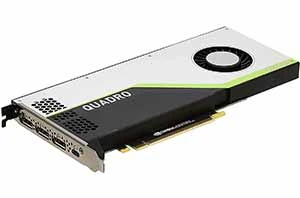
Finally, we have a beast, and this is the best GPU for Solidworks that you can get right now.
The PNY Quadro RTX 4000 offers 2304 CUDA cores, which is a massive number. This is capable of providing enough CUDA acceleration to get the work done in real-time. It means that you'll be able to monitor the changes you make instantly.
Plus, it offers all the modern features that you can ask for. You'll get real-time ray tracing support. This GPU is capable of casting 6.0 Giga Rays per second, offering superb performance. There are 43T RTX-OPS built into this GPU for ensuring constant performance.
It also comes with 288 tensor cores. These cores can harness the power of AI to improve the performance of the GPU, offering you a much smoother experience in return. The single-precision FP32 performance of this GPU peaked at an astonishing 7.1 TFLOPS.
Then again, there are three display ports that'll let you connect to three monitors. A card as powerful as this is bound to create a lot of heat. That is countered by a beefy 1.5-slot heatsink and a blower fan. If you're looking for the very best card out there, then you should certainly get this one.
Highlighted Features

| Product Name | CUDA Cores | GPU Memory | Outputs | Memory Interface |
| Asus GeForce GT 710 | 192 | 2GB | 1 HDMI, 1 DVI-I, 1 DSUB | 32-bit |
| Asus GeForce GT 710 | 640 | 4GB | 4 mDP 1.4 | 128-bit |
| PNY Quadro P4000 | 1792 | 8GB | 4 DP 1.4 | 256-bit |
| NVIDIA Quadro 600 | 96 | 1GB | 1 DVI, 1 DP | 128-bit |
| PNY Quadro RTX 4000 | 2304 | 8GB | 3 DP 1.4 | 256-bit |
Choosing a Solidworks graphics card can be a tough job. After all, there are so many things you must consider before settling on a specific model! To help you with that, we'll share a few tips that'll help you on your journey.
One of the worst mistakes people tend to make is going overboard or spending less than they should. This is why it's always important to determine how much you need to spend for getting the suitable Solidworks integrated graphics. It can be done easily.
All you need to do is consider the workload you're going to face. Will you be working on many projects at a time? Or will you be provided ample time for getting the rendering done? The answers will determine your choice greatly.
Don't go overboard with what you're spending, and definitely don't spend less than what you should.
Each graphics card offers a memory pool that's referred to as GPU memory. The more the memory of a specific card, the more workload it can take at a time. Then again, it's not only the memory bandwidth but also the technology that can have an impact on the performance.
For example, there was DDR5 memory earlier, which was replaced by GDDR6 memory. The latest technology NVIDIA came up with is GDDR6X memory, which is faster and more efficient than the previous generations.
A lot of people make the choice depending on the memory amount only, but that's the wrong way. You must consider the generation, too.
More cores definitely mean better, but this can get a bit complicated as GPUs from different brands are involved. Actually, there are only two brands, NVIDIA and AMD.
When it comes to AMD, there are the Radeon Pro GPUs. These GPUs come with OpenCL, and the number of computing units can be in two digits.
On the other hand, NVIDIA names these as 'CUDA Cores', and you're going to find thousands of CUDA cores in each GPU. Which ones do we recommend?
We highly recommend going for NVIDIA GPUs. This is mostly because their CUDA cores are highly optimized for handling Solidworks, making them Solidworks compatible graphics cards.
Thanks to innovation, you can get much more advanced features in the latest graphics card models. Other than better optimization, these also provide features such as real-time ray tracing and AI cores. These features will help you handle a heavier workload, reach higher, and have an efficient journey overall.

Yes, it's possible to check if a specific GPU is compatible with Solidworks. You just need to visit their official website. There you'll find an official list that'll provide the necessary information on this.
This list also includes Solidworks video cards, so you'll be able to know if pre-ordering a specific card is worth it or not.
Solidworks is one of the heaviest productivity applications out there. While it relies heavily on hardware, it depends largely on software, too. The drivers are the bridges that connect the application with the graphics cards, and thus it's important to keep them updated.
Ray tracing is the feature that automates the lighting and shadow of any virtual environment. This feature will help you create environments with dynamic lighting, and it will also save you from the toils of creating pre-baked lights.
The only thing that created the CUDA core supremacy is the amazing integration. OpenCL is very capable of handling any major workload. However, AMD just can't make those units work well with every application.
On the other hand, NVIDIA provides CUDA acceleration that's capable of driving even the heaviest applications smoothly.
Yes, and no. If you're an average user, then you'll be fine with consumer-grade GPUs. On the other hand, if this is your profession and you're passionate about it, then you should definitely go with a professional-grade GPU.
It's definitely a tough job to choose the best graphics card for Solidworks. However, this will become much easier with the help of our article. We've designed it with ample information that'll aid you to pick the right GPU for your work.
Plus, the recommendations provide the best Solidworks video cards in one place! With the help of our article, hopefully, you'll be able to get the right product. If you face any difficulty, resorting to our buying guide will help you clarify different aspects.
PNY NVIDIA Quadro RTX 4000 - The World’S First Ray Tracing GPU - Walmart, Etsy, eBay
EVGA GeForce RTX 2080 Ti Ftw3 Ultra, Overclocked, 2.75 Slot Extreme Cool Triple + iCX2, - Walmart, Etsy, eBay
ZOTAC Gaming GeForce RTX 2060 6GB GDDR6 192-bit Gaming Graphics Card, Super Compact, - Walmart, Etsy, eBay
PNY NVIDIA Quadro RTX 8000, Black, Green, Silver (VCQRTX8000-PB) - Walmart, Etsy, Ebay
Nvidia GeForce RTX 2080 Founders Edition - Walmart, Etsy, eBay
NVIDIA GeForce RTX 2080 Super Founders Edition Graphics Card - Walmart, Etsy, eBay
 |
 |
 |
 |

About Malcolm Woods
Malcolm Woods is a blogger who enjoys writing about technology and solar power. He has a passion for learning new things, and loves to share his knowledge with others. Malcolm is also an advocate for sustainable living, and believes that everyone has a responsibility to do their part in preserving our planet.
 |
 |
 |
 |